Fowler A. Mathematical Geoscience
Подождите немного. Документ загружается.


240 4 River Flow
Fig. 4.7 Laminar roll waves following rainfall at Craggaunowen, Co. Clare, Ireland. The water
depth is a few millimetres and the wavelength of the order of twenty centimetres
Substitution of (4.97) into the second equation yields a single first-order equation
for u,orh. We choose to write the equation for h, thus
h
=
h
3
−(ch −K)
2
γ
2
h
3
−K
2
. (4.100)
As indicated in Fig. 4.8, we aim to solve this equation in (0,L), with h = h
+
at
ξ =0 and h = h
−
at ξ =L. The quantities involved in this equation and its boundary
conditions are L, c, h
−
, h
+
and K, and these have to be determined. Solution of the
differential equation (4.100) from 0 to L yields one condition,
L =
h
−
h
+
γ
2
h
3
−K
2
h
3
−(ch −K)
2
dh, (4.101)
which determines L in terms of the other quantities. Thus four extra conditions need
to be specified to determine these.
There are two jump conditions to apply across the shock. These are conservation
of mass, which we omit, as it is automatically satisfied by (4.97), and conservation
of momentum, which has the form
c =
hu
2
+
1
2
γ
2
h
2
+
−
[hu]
+
−
. (4.102)
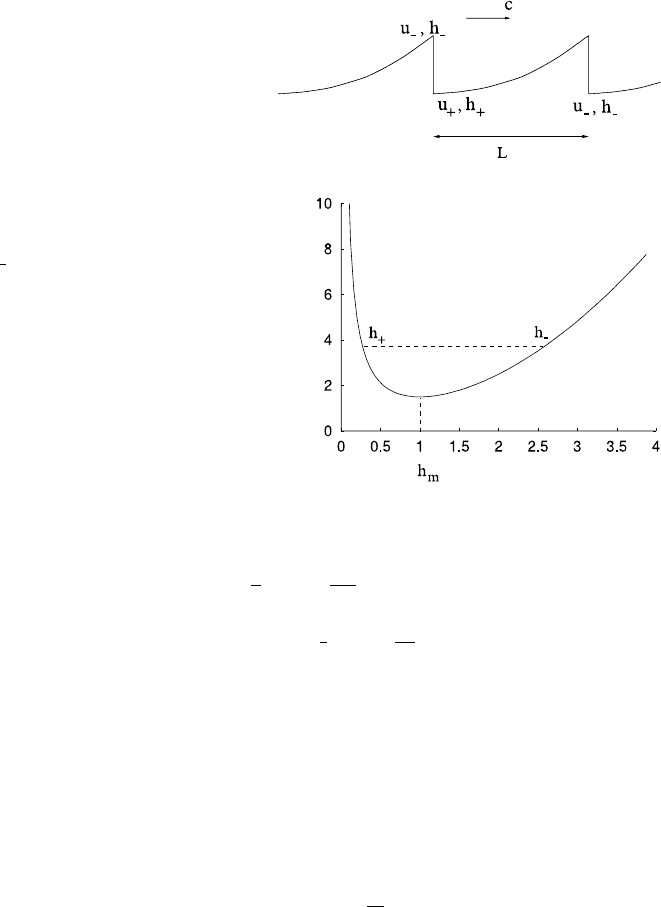
4.5 Nonlinear Waves 241
Fig. 4.8 Schematic form of
roll waves
Fig. 4.9 Supercritical and
subcritical values of h across
a shock: graph of
1
2
γ
2
h
2
+K
2
/h, γ =K =1
Simplification of this using (4.97)gives
1
2
γ
2
h
2
+
K
2
h
+
−
=0. (4.103)
Evidently, consideration of the graph of
1
2
γ
2
h
2
+
K
2
h
shows that this determines h
+
in terms of h
−
, for given K, see Fig. 4.9.
We denote the critical value of h at the minimum in Fig. 4.9 as h
m
, thus
γ
2
h
3
m
=K
2
; (4.104)
clearly we must have h
−
>h
m
and h
+
<h
m
(this is also implied by (4.99)), that
is to say, the flow is subcritical behind the shock and supercritical in front of it. In
particular, there is a value of ξ ∈(0,L)with h =h
m
, and in order that the derivative
in (4.100) remain finite, it is necessary that the numerator also vanish at this point.
Since K>0, this implies
ch
m
−K =
K
γ
. (4.105)
We have added an extra quantity h
m
to the other unknowns L, h
−
, h
+
, K and
c. To determine these six quantities, we have the four Eqs. (4.101), (4.103), (4.104)
and (4.105). This appears to imply that the roll waves described here form a two pa-
rameter family, with (for example) the wavelength and wave speed being arbitrary.
This is at odds with our expectation that a sensibly described physical problem will
have just the one solution. In order to understand this, we need to reconsider the

242 4 River Flow
hyperbolic form of the describing Eqs. (4.90). A natural domain on which to solve
these equations is the semi-infinite real axis s>0, in which case appropriate bound-
ary conditions are to prescribe h and u on t = 0 and s =0. The initial conditions
are prescribed to represent the experimental start-up, and the boundary conditions
at s = 0 must represent the inlet conditions. The effect of the initial conditions is
washed out of the system as the characteristics progress down stream, and the roll
waves which are observed are determined by the boundary conditions at s =0.
Of course, these inlet conditions are not generally consistent with a periodic trav-
elling wave solution, but we would expect that prescribed values of u and h at the
inlet would provide the extra two parameters to fix the solution precisely. One such
parameter is easy to assess. Because mass is conserved, the mean volume flux must
be equal to that at the inlet, and by choice of the velocity and depth scales, we can
take the volume flux to be one, whence
1
L
L
0
(ch −K)dξ =1. (4.106)
It is not as obvious how to provide the other recipe, because the mean momentum
flux is not conserved downstream; its value at the inlet does not tell us its value
downstream. This is because of the gravity and friction terms. However, it is the
case that these terms must balance on average, that is to say,
L
0
h −u
2
dξ =0; (4.107)
this actually follows by integrating the momentum equation (written in conservation
form) over a wavelength. The momentum advection and pressure gradient terms
vanish because of (4.103), leaving (4.107). This appears to give a final condition to
close the system: but it does not, as (4.107) actually reduces to (4.103) when the
integration is carried out. An appropriate final condition is not easy to determine;
we provide some further discussion below. Before that, we reduce the conditions
above to a simpler form.
We rewrite the relations (4.101), (4.103), (4.104), (4.105) and (4.106)usingh
m
as the defining parameter, and putting
h
+
=h
m
φ
+
,h
−
=h
m
φ
−
; (4.108)
then we have K and c given by
K =γh
3/2
m
,c=h
1/2
m
(1 +γ), (4.109)
and L, φ
+
and φ
−
are determined, after some algebra, by
L =γ
2
h
m
φ
−
φ
+
(φ
2
+φ +1)dφ
(φ −γ)
2
−γ
2
φ
,
1 =
γ
2
h
5/2
m
L
φ
−
φ
+
(φ
2
+φ +1){φ +γ(φ−1)}dφ
(φ −γ)
2
−γ
2
φ
,
1
2
φ
2
+
1
φ
+
−
=0,
(4.110)

4.5 Nonlinear Waves 243
where we have taken Q =1in(4.106). The second of these can be written indepen-
dently of L as
q =
φ
−
φ
+
(φ
2
+φ+1){φ+γ(φ−1)}dφ
(φ−γ)
2
−γ
2
φ
φ
−
φ
+
(φ
2
+φ+1)dφ
(φ−γ)
2
−γ
2
φ
, (4.111)
where
q =
1
h
3/2
m
. (4.112)
The profile of φ is given by the scaled version of (4.100), which is
φ
=
(φ −γ)
2
−γ
2
φ
γ
2
h
m
(φ
2
+φ +1)
. (4.113)
The numerator must be positive, and since φ =1forsomeξ, a necessary condition
forthistobetrueisthatγ<1/2. In terms of the Froude number, this is F>2,
which is the condition under which the roll wave instability occurs in the first place.
This nicely suggests that the roll waves bifurcate as a non-uniform solution from the
steady state at F =2.
It is apparent from the above discussion that the crux of the determination of the
roll wave parameters is the solution of (4.110)
3
and (4.111) for given positive q.If
φ
+
and φ
−
can be found for any such q, then they can be found for any h
m
,after
which L, K and c follow directly from (4.109) and (4.110)
1
.
To find the solutions of (4.110)
3
and (4.111), we note that φ
+
and φ
−
are
uniquely defined in terms of the ordinate of the graph in Fig. 4.9; in fact, for any
φ
+
∈(0, 1),(4.110)
3
gives the explicit solution
φ
−
=
1
2
−φ
+
+
φ
2
+
+
8
φ
+
1/2
; (4.114)
then (4.111)givesq = q(φ
+
;γ). The other constants are then given explicitly by
(4.109), (4.110)
1
and (4.111), and in particular, if we define
N(φ
+
) =
φ
−
φ
+
(φ
2
+φ +1){φ +γ(φ−1)}dφ
(φ −γ)
2
−γ
2
φ
,
D(φ
+
) =
φ
−
φ
+
(φ
2
+φ +1)dφ
(φ −γ)
2
−γ
2
φ
(4.115)
(thus q =N/D), then using
h
m
=
D
N
2/3
, (4.116)
we have
L =
γ
2
D
5/3
N
2/3
,c=
(1 +γ)D
1/3
N
1/3
,K=
γD
N
. (4.117)
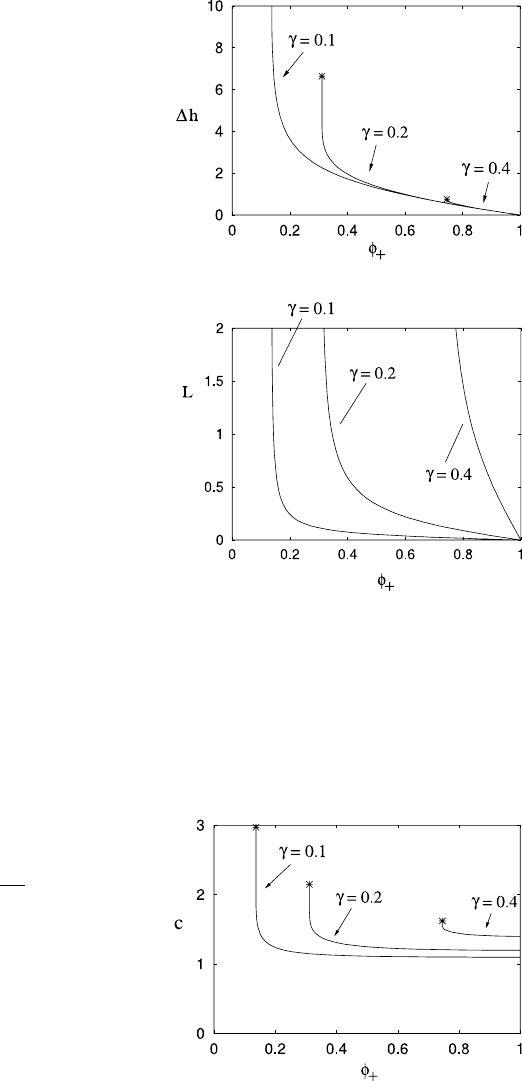
244 4 River Flow
Fig. 4.10 Graphs of
h =h
−
−h
+
as a function
of φ
+
for γ = 0.1(F =10),
γ =0.2(F =5) and γ =0.4
(F = 2.5). The asterisks mark
the ends of the curves at
φ
+
=α
+
Fig. 4.11 Dimensionless
wavelength L in terms of φ
+
for γ =0.1(F = 10),
γ =0.2(F =5) and γ =0.4
(F = 2.5). The curves do not
terminate, since
L ∼−ln[φ
+
−α
+
] as
φ
+
→α
+
Equations (4.114), (4.116) and (4.117) determine φ
−
, h
m
, L, c and K in terms
of φ
+
. From these we can find h
−
and h
+
. Thus it is convenient in computing the
one parameter family of wave solutions to use φ
+
as the parameter.
In Figs. 4.10, 4.11, 4.12 we plot the wave height h =h
m
(φ
−
−φ
+
), wavelength
L and speed c (all dimensionless) as a function of the parameter φ
+
, for various
values of the Froude number F .
Fig. 4.12 Wave speed c in
terms of φ
+
.Theasterisks
mark the ends of the curves at
φ
+
=α
+
, c =c
+
=
1+γ
q
1/3
+
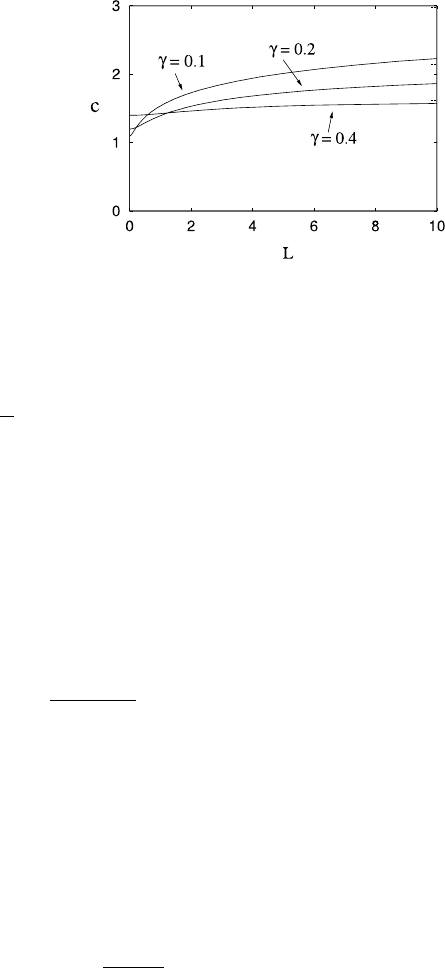
4.5 Nonlinear Waves 245
Fig. 4.13 Wave speed c as a
function of L,forγ = 0.1,
γ =0.2andγ = 0.4. The
short dashed lines at the right
ordinate indicate the
corresponding asymptotes c
+
for γ =0.1andγ =0.2and
γ =0.4 at the respective
values c
+
=2.9717, 2.1495,
1.6216
A feature of Fig. 4.10 is the termination of the curves at a finite value. The inte-
grals which define N and D in (4.115) can be explicitly evaluated. If we define the
two (positive) roots of (φ −γ)
2
−γ
2
φ =0tobe
α
±
=
γ
2
2 +γ ±
γ
2
+4γ
1/2
, (4.118)
thus α
+
>α
−
> 0, then we restrict φ
+
>α
+
so that φ
> 0in(4.113). Consideration
of N and D then shows that
D =−A ln(φ
+
−α
+
) +O(1), N =−C ln(φ
+
−α
+
) +O(1) (4.119)
as φ →α
+
. From this it follows that q →q
+
as φ →α
+
, where q
+
=C/A, and is
given explicitly by
q
+
=(1 +γ)α
+
−γ. (4.120)
These termination points are marked by asterisks at the end of the curves in
Fig. 4.10. Because q = q
+
+O(
1
−ln(φ
+
−α
+
)
), the slope of the curves is infinite at
these points. (This also makes it hard to draw the figures. To get within 0.02 of q
+
,
for example, we can expect to have to take φ
+
−α
+
≈exp(−50) ≈10
−22
!)
As φ
+
→1, then also φ
−
→1, and hence both N and D are O(1). Direct con-
sideration of (4.115) shows that q → 1asφ
+
→ 1. As a consequence of these
limiting behaviours, L →0 and c is finite as φ
+
→1, while L →∞as φ
+
→α
+
,
but c tends to a finite limit just as q does. As shown in Figs. 4.10–4.12, all three
quantities vary monotonically between φ
+
= α
+
and φ
+
= 1, and consequently c
is a monotonically increasing function of L, which tends to a limit c
+
as L →∞,
where
c
+
=
(1 +γ)
q
1/3
+
. (4.121)
This is shown in Fig. 4.13. Analysis of the limit φ
+
→ α
+
shows that c = c
+
+
O(1/L) as L →∞(Question 4.15), and evidently the approach to the limit is slow,
particularly at low γ (high Froude number).

246 4 River Flow
Wavelength Selection and Boundary Conditions
Although it is convenient to compute the properties of the roll waves using the pa-
rameter φ
+
, it is more natural to use the wavelength L as the single parameter. The
issue remains how this is selected. This seems to be an open problem, on which we
offer some comments, though little further insight.
The first thing to note is that the hyperbolic St. Venant equations (4.90) require
two initial conditions at the inlet s = 0 if the Froude number F>1. If we imagine
flow from a vent below a dam, for example, it is easy to see that prescription of both
h and hu (and thus u) can be effected, by having a vent opening of a prescribed
height, and adjusting the dam height to control mass flow. From a mathematical
point of view, precisely steady inlet conditions h = u = 1 lead to uniform down-
stream flow, provided the St. Venant equations apply precisely. Thus we can see
that it is only through the prescription of a time varying inlet velocity, for exam-
ple, that roll waves can develop downstream. For example, we might prescribe inlet
conditions
h =1,u=1 +λ cosωt at s =0, (4.122)
where λ 1. We would then infer that the resulting periodic solution would have
frequency ω, and this would prescribe the ratio
L
c
=ω, (4.123)
which would provide the final prescription of the solution. Consulting Fig. 4.13,we
can see that (4.123) would indeed determine a unique value of L.
More generally, we might suppose u(0,t) to be a polychromatic, perhaps
stochastic function. We might then expect the wavelength selected to be that of
the most rapidly growing mode. Consultation of (4.85), however, indicates that for
F>2, p and thus Reσ is an increasing function of wave number k, with p → F
as k →∞. This unbounded growth at large wave number is suggestive of ill-
posedness, and in any case is certainly not consistent with the apparent observation
that long wavelength roll waves are in practice selected.
A final consideration, and perhaps the most practical one, is that wavelength
selection may take place at large times through the interaction of neighbouring wave
crests. Larger waves move more rapidly (c is an increasing function of h if we
plot one in terms of the other), and therefore larger waves will catch smaller ones.
This provides a coarsening effect, whereby smaller waves can be removed by larger
ones. Since h is also an increasing function of L, this coarsening does indeed
lead to longer waves. The process should be limited by the fact that very long (and
thus flat) waves will be subject to the same Vedernikov instability as is the uniform
state.
4
If we supposed that wavelength varied slowly from wave to wave, we can
see the beginnings of a kind of nonlinear multiple scales method to describe the
evolution of wavelength as a function of space and time. It is less easy to see how
4
This observation is due to Neil Balmforth.

4.5 Nonlinear Waves 247
to incorporate the generation of new waves in such a framework, however, and this
problem remains open for investigation.
The spectre of ill-posedness described above raises the related issue of how to
prescribe the correct boundary conditions for the St. Venant equations. The reason
there is an issue is that the equations require two upstream boundary conditions if
F>1, but one upstream and one downstream condition if F<1. This makes no
sense, insofar as the boundary conditions should be prescribed independently of the
solution. A resolution of this conundrum lies in the realisation that the formation of
shocks in the hyperbolic system suggests the presence of a missing diffusive term,
and this takes the form of a turbulent eddy viscous term.
In our discussion of the basal friction term (4.5), we assumed only the transverse
Reynolds stress −ρ
u
w
≈μ
T
∂ ¯u
∂z
was significant. The longitudinal Reynolds stress
−ρ
u
2
≈μ
T
∂ ¯u
∂x
is small, but provides a crucial diffusive term
∂
∂x
μ
T
A
∂u
∂x
(4.124)
to be added to the right hand side of (4.43). Following (B.9) in Appendix B,we
suppose
μ
T
=ρε
T
[u]d, (4.125)
and this leads to the corrective term
ε
T
F
2
S
1
A
∂
∂x
A
∂u
∂x
(4.126)
to be added to (4.49)
2
. Correspondingly, Eqs. (4.90) are modified to
h
t
+(hu)
s
=0,
u
t
+uu
s
+γ
2
h
s
=γ
2
1 −
u
2
h
+
κ
h
∂
∂s
h
∂u
∂s
,
(4.127)
where
κ =ε
T
S 1. (4.128)
A typical value of κ is ∼10
−5
.
Because κ is small, it can be expected to provide a shock structure for the shocks
we have described. In addition, the extra derivative suggests that an extra boundary
condition for the system (4.127) needs to be prescribed. Most obviously, this is at
the outlet, where the river meets the sea. The most obvious such condition might be
to prescribe h, or perhaps h
x
, but it is more likely that one should prescribe
u =0ats =1, (4.129)
indicating the flow of the river into a large reservoir. In any event, the extra condition
at the outlet, together with the diffusive term (4.124), can explain the difference in
the solutions when F ≶ 1. The characteristics of (4.90) are the sub-characteristics
of (4.127), and the appropriate pair of conditions to apply for (4.90) is determined
by the correct way of determining the singular approximation when κ →0.
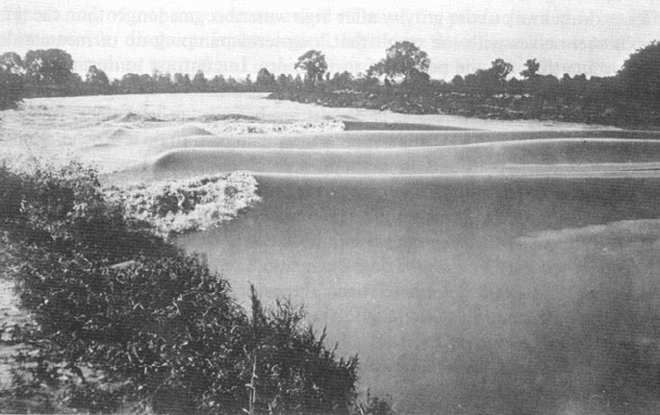
248 4 River Flow
Fig. 4.14 The Severn bore. This is a famous photograph from 1921, when there were no by-
standers, and certainly no surfers. Reproduced from Pugh (1987). The photograph first appears in
the book by Rowbotham (1970), where Mr C.W.F. Chubb is acknowledged as the photographer
However, this really sheds no further light on the issue of roll wave length selec-
tion. When F>2, clearly two conditions are appropriate at s =0, but how these
conspire to select the wavelength is unclear.
4.5.3 Tidal Bores
A bore on a river is a shock-like wave which travels upstream, and it occurs because
of forcing at the mouth of the river due to tidal variation in sea level. In England the
best known example is the Severn bore, which occurs because of the very high tidal
range in the Severn estuary. Large crowds come to view the bore, which manifests
itself as a wall of water about a metre high advancing up river at a speed of some
four to five metres a second. Figures 4.14 and 4.15 show photographs of the Severn
bore. Bores occur on certain rivers due to a confluence of factors. The tidal range has
to be very large, and this can be caused by tidal resonance in an estuary; in addition,
the river must narrow dramatically upstream, so that the estuary acts like a funnel.
The wave then forms because the rapidly rising water level in the estuary causes a
large upstream water flux, and with a sufficiently large funnelling effect, a shock
wave will be formed. Bores occur all over the world, for example in the Amazon,
the Seine, the Petitcodiac river which flows into the Bay of Fundy, and the Tsien
Tang river in China. Where they occur, they are spectacular, but relatively few rivers
have them, because of the severity of the necessary conditions for their formation.
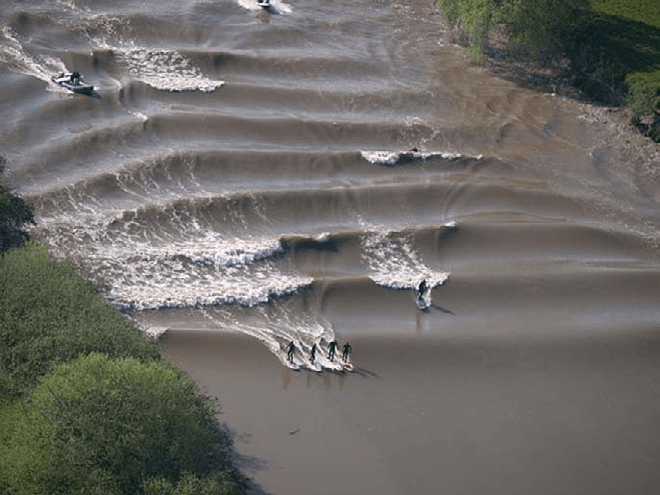
4.5 Nonlinear Waves 249
Fig. 4.15 The Severn bore, viewed from the air in a microlight aircraft by Mark Humpage. The
image is copyright Mark Humpage, and is reproduced with his permission. For other photographs,
see http://www.markhumpage.com. The undular nature of the bore is very clearly visible (as are
the relentless surfers)
Figure 4.16 shows the geometry of the Severn river and estuary. The bore forms
near Sharpness, and is best viewed at various places further upstream, notably Min-
sterworth and Stonebench, where public access is available. Figure 4.17 shows a
profile of the river during passage of a bore. There are certain features evident
in this figure which are relevant when we formulate a model. The river depth at
low stage is about a metre, whereas the tidal range is much greater than this. In
the Severn estuary, it can be 14.5 metres, and at Sharpness, it is 9 metres in the
figure. The other feature of importance is the apparent alteration in the bedslope
as the estuary is approached. As an idealisation of this, Fig. 4.18 shows the ba-
sic geometry of a river–estuary system, which we can use to explain bore forma-
tion.
The river in Fig. 4.18 flows into a tidal basin, where the water level fluctuates
tidally with a period of slightly more than twelve hours. Such fluctuations cause
the river/estuary boundary point to migrate back and forth. In particular, approach-
ing high tide this point moves upstream. The idea behind bore formation is that
if the upstream velocity of this boundary is faster than the upstream characteristic
